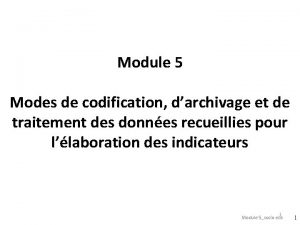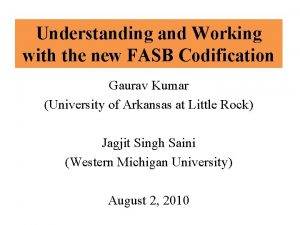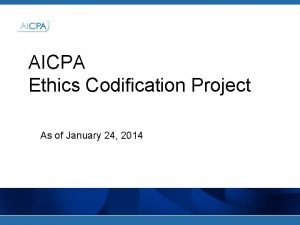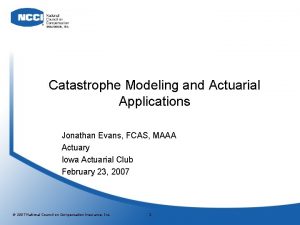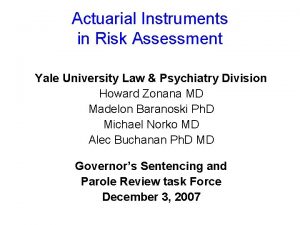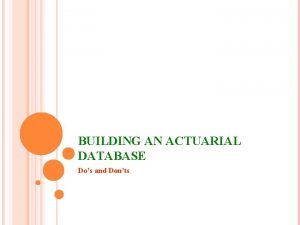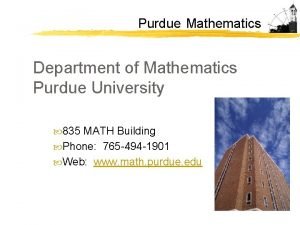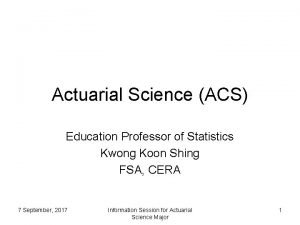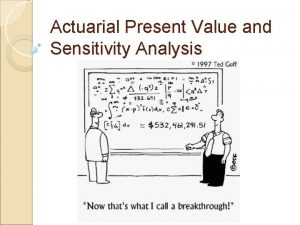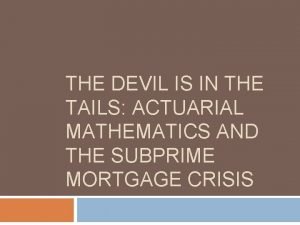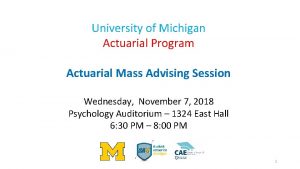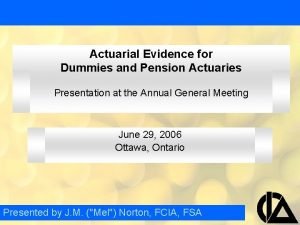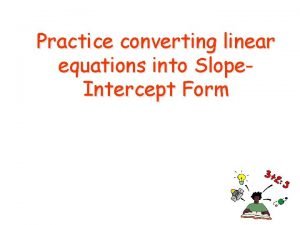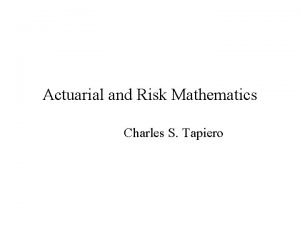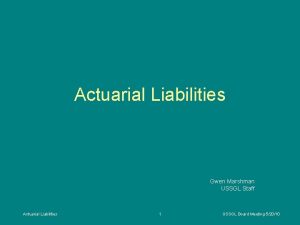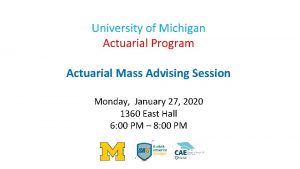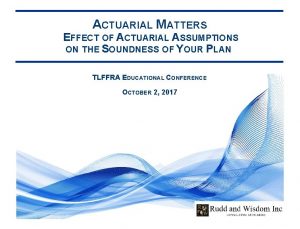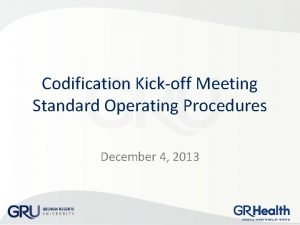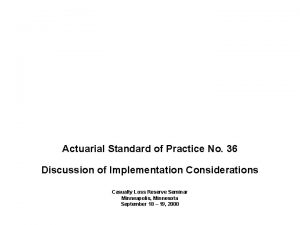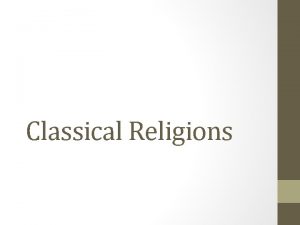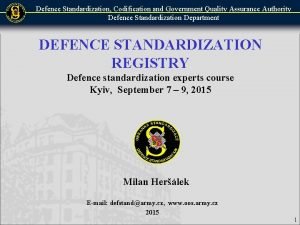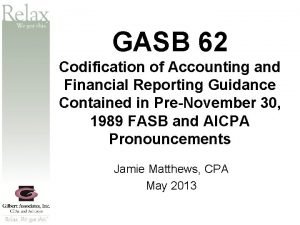Actuarial Standard of Practice No 36 and Codification






























- Slides: 30

Actuarial Standard of Practice No. 36 and Codification of Statutory Accounting Discussion of Implementation Considerations CLRS New Orleans, LA September 10 -11, 2001

Today’s discussion facilitated by: Mary D. Miller, Moderator, Ohio Department of Insurance Pat Teufel, KPMG LLP Charles Yesker, Interstate Insurance Group

Today’s Discussion Will Focus on: – Risk of Material Adverse Deviation – Codification – Materiality

Overview: ASOP 36 § Effective: For All Statements of Actuarial Opinion provided for reserves with a valuation date on or after October 15, 2000 § Defines 5 Types of Opinions l l l Determination of Reasonable Provision Determination of Deficient or Inadequate Provision Determination of Redundant or Excessive Provision Qualified Opinion No Opinion § Introduces Disclosure Requirements

Disclosure Requirements § Deficient or Excessive Reserves Amount by which the stated reserve would need to increase/decrease to equal the minimum/maximum reasonable amount § Qualified Opinion • • Description of the qualification and reasons Amounts for such items included in the stated reserves, if disclosed by the entity If amounts not disclosed by the entity, a statement that the stated reserves include unknown amounts for such items Risk of Material Adverse Deviation

Risk of Material Adverse Deviation – – Where the actuary believes that there are significant risks and uncertainties that could result in material adverse deviation, an explanatory paragraph is required The explanatory paragraph should contain: l l The amount of adverse deviation that the actuary judges to be material A description of the major factors or particular conditions underlying risks and uncertainties

Practical Considerations – For NAIC Opinions, Direct and Assumed vs. Net l Possibility l Implicit for different conclusions requirement for different disclosures

Overview: Codification l l l Effective January 1, 2001 Recognized as OCBOA by accounting profession Considerations for opining actuary Management’s Best Estimate 2. Major Risk Factors vs. Material Adv. Deviation 3. Premium Deficiency Reserves 4. Pools and Associations 5. Assessments, e. g. Guaranty Fund 1.

Management’s Best Estimate l l l By “line of business” and in aggregate Required for loss reserves and recordable loss contingencies But “best estimate” and “line of business” are undefined – Reasonably certain that “best estimate” is not mean, median, or mode – “Line of business” is not necessarily annual statement LOB, and may relate more to marketing considerations l BI vs. PD vs. Phys. Dam vs. Personal Auto vs. Homeowners vs. Personal Lines

Management’s Best Estimate l Management’s best estimate may differ from actuary’s point estimate – Management should be prepared to document reason for differences – Actuary can work with management to construct a letter that documents the reasons for differences – It will be the auditors (not the actuaries) who will be concerned about how management’s best estimate is determined – Actuary may wish to obtain a letter of representation stating that reserves reflect management's best estimate by LOB and in aggregate

What does this mean? l l Management currently should be booking its best estimate Required documentation could be more stringent It is uncertain how the auditors will interpret this requirement Seems to place the spotlight on management’s decision

Materiality (Section 3. 4) “Material” or “materiality” mentioned at least thirteen (13) times in the ASOP The actuary is directed to: – Consider the purposes and intended uses for which the actuary prepared the statement of actuarial opinion – Use professional judgment as well as materiality guidelines or standards applicable to the Standard of Actuarial Opinion and the actuary’s intended purpose for the opinion. – Principal use of materiality in the ASOP is to determine if an explanatory paragraph is needed –

Where Can We Look for Guidance? Property and Casualty Practice Note for Statements of Actuarial Opinion: Appendix 7 • Summarizes materiality references in ASOP 36 • Reviews materiality as referenced in • • • SEC Staff Accounting Bulletin No. 99 NAIC Accounting Practices and Procedures Manual Highlights relevant numerical considerations

Materiality Considerations – – – – Single vs. Multiple Line Company Net Retention Single Company vs. Member of a Group Access to Capital Management Prior loss reserve runoff Financial Strength

What financial values are important to the intended user? l l l Regulator Statutory Surplus Risk Based Capital Total Reserves IRIS Tests l l Investor Net Worth Net Income Earnings per Share

Case Studies § § § § Mutual Auto Insurance Company Multi-Line Casualty Company Small Nonstandard Auto Insurance Company New Workers Compensation Insurance Company Lawyers Professional Liability Mutual Insurance Company Physicians’ Medical Malpractice Insurance Company Reinsurance Company

Mutual Auto Insurance Company 1996 1997 1998 1999 2000 Surplus 25, 120 30, 054 37, 608 41, 766 45, 792 NWP 24, 283 25, 060 25, 223 24, 733 23, 994 0. 97 0. 83 0. 67 0. 59 0. 52 14, 525 14, 555 0. 32 NWP to Surplus Reserves to Surplus Loss Reserve Development -12. 6% -9. 5% -5. 2% -3. 9% Net Income 972 2, 343 2, 450 1, 013 842 Best’s Rating A++ A++ A++ RBC Ratio 7. 0 7. 1 6. 5 7. 9 9. 8

Mutual Auto Insurance Company l Actuarial Point Estimate = 14, 300 l Range of Reasonable Reserves § l 13, 825 to 14, 972 High End of Range - Carried = 417 § § § 2. 9% of Reserves. 9% of Surplus 49. 5% of Net Income

Multi-line Casualty Insurance Company 1996 1997 1998 1999 2000 Surplus 121, 337 115, 728 128, 811 123, 289 84, 851 NWP 122, 945 158, 182 93, 341 99, 390 75, 892 1. 01 1. 37 0. 72 0. 81 0. 89 113, 867 111, 829 0. 92 1. 32 <3, 857> NWP to Surplus Reserves to Surplus Net Income <6, 401> <2, 893> 10, 733 <5, 231> Loss Reserve Development +22. 0% +21. 9% +20. 2% +17. 0% Best’s Rating A- A- B++ RBC Ratio 3. 8 4. 5 6. 0 5. 9 4. 1

Multi-line Casualty Insurance Company l Actuarial Point Estimate = 114, 500 l Range of Reasonable Reserves § l 109, 687 to 119, 458 High End of Range - Carried = 7, 629 § § § 6. 8% of Reserves 9. 0% of Surplus -197. 8% of Net Income

Small Nonstandard Auto Insurance Company 1996 1997 1998 1999 2000 5, 818 5, 751 5, 748 5, 098 5, 953 NWP 465 6, 379 11, 266 11, 793 20, 412 NWP to Surplus 0. 08 1. 11 1. 96 2. 31 3. 43 Reserves 9, 369 13, 624 Reserves to Surplus 1. 84 2. 29 34 Surplus Net Income <179> <451> 60 1, 185 Loss Reserve Development -33. 3% -0. 9% -9. 0% +0. 8% NR-1 NR-2 6. 2 4. 7 3. 3 2. 1 Best’s Rating RBC Ratio 11. 5

Small Nonstandard Auto Insurance Company l Actuarial Point Estimate = 13, 250 l Range of Reasonable Reserves § l 12, 867 to 14, 458 High End of Range - Carried = 834 § § § 6. 1% of Reserves 14. 0% of Surplus 2452. 9% of Net Income

New Workers Compensation Insurance Company 1996 1997 1998 1999 2000 Surplus 5, 016 5, 377 6, 210 6, 361 NWP 1, 553 3, 390 6, 009 7, 863 NWP to Surplus 0. 31 . 63 0. 97 1. 24 Reserves 220 1, 856 4, 263 4, 832 Reserves to Surplus 0. 04 0. 35 0. 69 0. 76 Net Income <46> 261 831 1, 019 +13. 6% -24. 1% -10. 1% NR-2 B+ 11. 2 9. 8 7. 6 Loss Reserve Development Best’s Rating RBC Ratio 15. 3

New Workers Compensation Insurance Company l Actuarial Point Estimate = 4, 800 l Range of Reasonable Reserves § l 4, 287 to 6, 058 Maximum Adverse Deviation = 1, 226 § § § 25. 4% of Reserves 19. 3% of Surplus 120. 3% of Net Income

Lawyers Professional Liability Mutual Insurance Company 1996 1997 1998 1999 2000 Surplus 6, 305 7, 329 7, 334 8, 154 9, 641 NWP 3, 347 4, 593 4, 864 5, 678 5, 979 NWP to Surplus 0. 53 0. 66 0. 70 0. 62 Reserves 6, 401 8, 178 8, 536 10, 141 11, 291 Reserves to Surplus 1. 02 1. 16 1. 24 1. 17 Net Income 742 703 278 721 1, 079 + 4. 2% - 0. 5% -18. 4% -13. 4% Best’s Rating B++ B++ B++ RBC Ratio 4. 7 4. 8 4. 5 4. 6 4. 4 Loss Reserve Development

Lawyers Professional Liability Mutual Insurance Company l Actuarial Point Estimate = 10, 900 l Range of Reasonable Reserves § l 9, 647 to 12, 798 High End of Range - Carried = 1, 507 § § § 13. 3% of Reserves 15. 6% of Surplus 139. 7% of Net Income

Physicians’ Medical Malpractice Insurance Company 1996 1997 1998 1999 2000 Surplus 134, 431 158, 621 172, 712 187, 224 211, 140 NWP 96, 809 85, 532 104, 953 134, 215 141, 016 0. 72 0. 54 0. 61 0. 72 0. 67 636, 966 563, 768 593, 282 654, 132 654, 865 4. 74 3. 55 3. 44 3. 49 3. 10 <3, 157> 22, 960 11, 335 11, 968 21, 250 - 2. 1% - 4. 0% - 4. 7% - 3. 4% B B B+ B++ 3. 9 4. 5 5. 6 6. 0 5. 7 NWP to Surplus Reserves to Surplus Net Income Loss Reserve Development Best’s Rating RBC Ratio

Physicians’ Medical Malpractice Insurance Company l Actuarial Point Estimate = 630, 175 l Range of Reasonable Reserves § l 579, 647 to 692, 789 High End of Range- Carried = 37, 924 § § § 5. 8% of Reserves 18. 0% of Surplus 178. 5% of Net Income

Reinsurance Company 1996 1997 1998 1999 2000 Surplus 272, 374 396, 677 423, 616 402, 652 401, 392 NWP 205, 065 429, 870 645, 832 698, 440 653, 984 0. 75 1. 08 1. 52 1. 73 1. 63 1, 038, 460 1, 179, 181 2. 58 2. 94 8, 375 NWP to Surplus Reserves to Surplus Net Income 22, 980 <17, 164> 35, 794 1, 264 Loss Reserve Development + 1. 8% + 7. 9% + 7. 5% + 6. 7% A A A+ A+ A+ 25. 2 18. 9 15. 7 12. 4 9. 8 Best’s Rating RBC Ratio

Reinsurance Company l Actuarial Point Estimate = 1, 225, 850 l Range of Reasonable Reserves § l 1, 079, 647 to 1. 292, 481 High End of Range - Carried = 113, 300 § § § 9. 6% of Reserves 28. 2% of Surplus 1352. 8% of Net Income
 Codification par tranche
Codification par tranche Tableau de dépouillement questionnaire
Tableau de dépouillement questionnaire Fasb codification system
Fasb codification system Subordinate legislation in india
Subordinate legislation in india Codification vs personalization
Codification vs personalization Codification of knowledge
Codification of knowledge The aicpa ethics codification includes which sections?
The aicpa ethics codification includes which sections? Financial engineering ku leuven
Financial engineering ku leuven Acr format resume
Acr format resume Penn state actuarial science
Penn state actuarial science Catastrophe modeling actuarial
Catastrophe modeling actuarial Yale actuarial science
Yale actuarial science Actuarial management
Actuarial management Provision for unrealised profit
Provision for unrealised profit Actuarial database
Actuarial database Math building purdue
Math building purdue Southampton actuarial science
Southampton actuarial science Actuarial science smu
Actuarial science smu Actuarial present value
Actuarial present value Actuarial mathematics
Actuarial mathematics Conrad siegel 401k
Conrad siegel 401k Student actuaries at michigan
Student actuaries at michigan Shepherd fungura
Shepherd fungura Actuarial jokes
Actuarial jokes Actuarial evidence
Actuarial evidence Standard error for mean
Standard error for mean Power dynamics of standard language
Power dynamics of standard language Objectives of standard costing
Objectives of standard costing Practice assessor feedback examples
Practice assessor feedback examples Peruntukan masa kssm 2020 menengah rendah
Peruntukan masa kssm 2020 menengah rendah Converting equations to slope intercept form
Converting equations to slope intercept form

